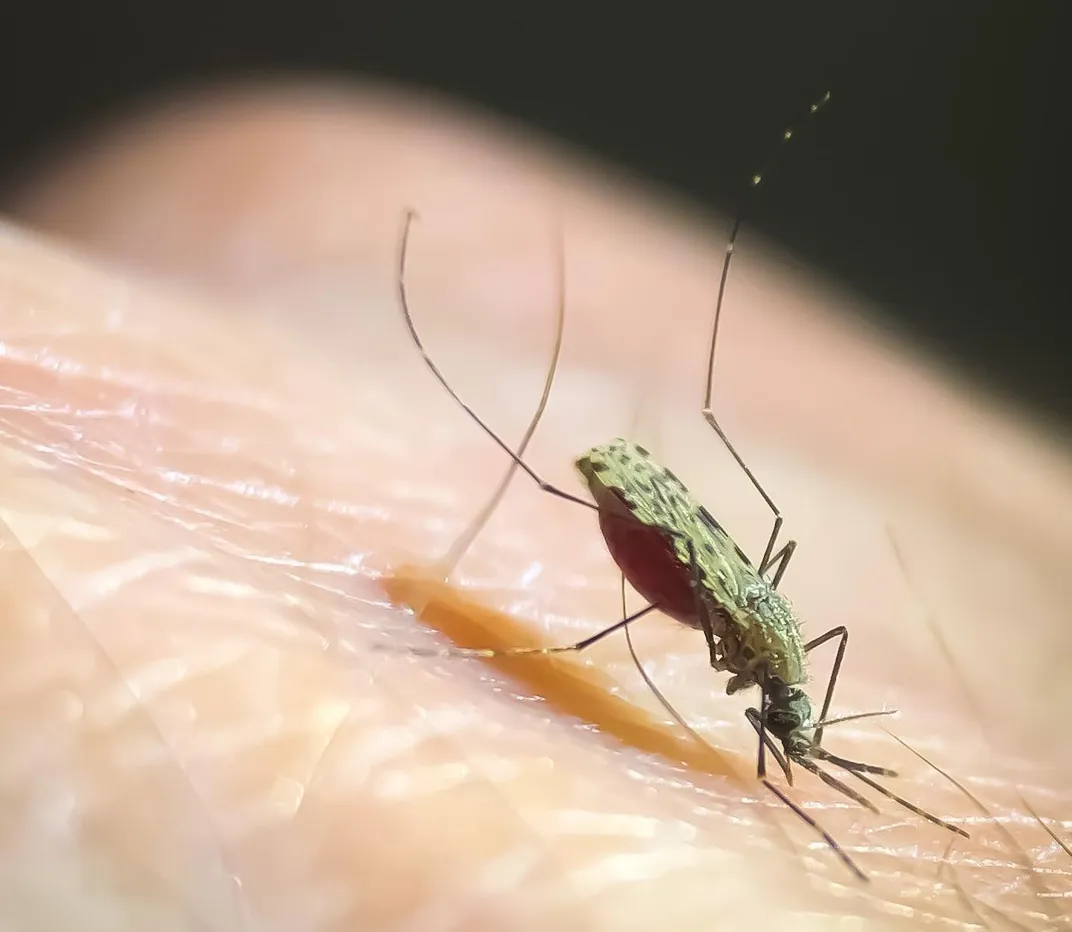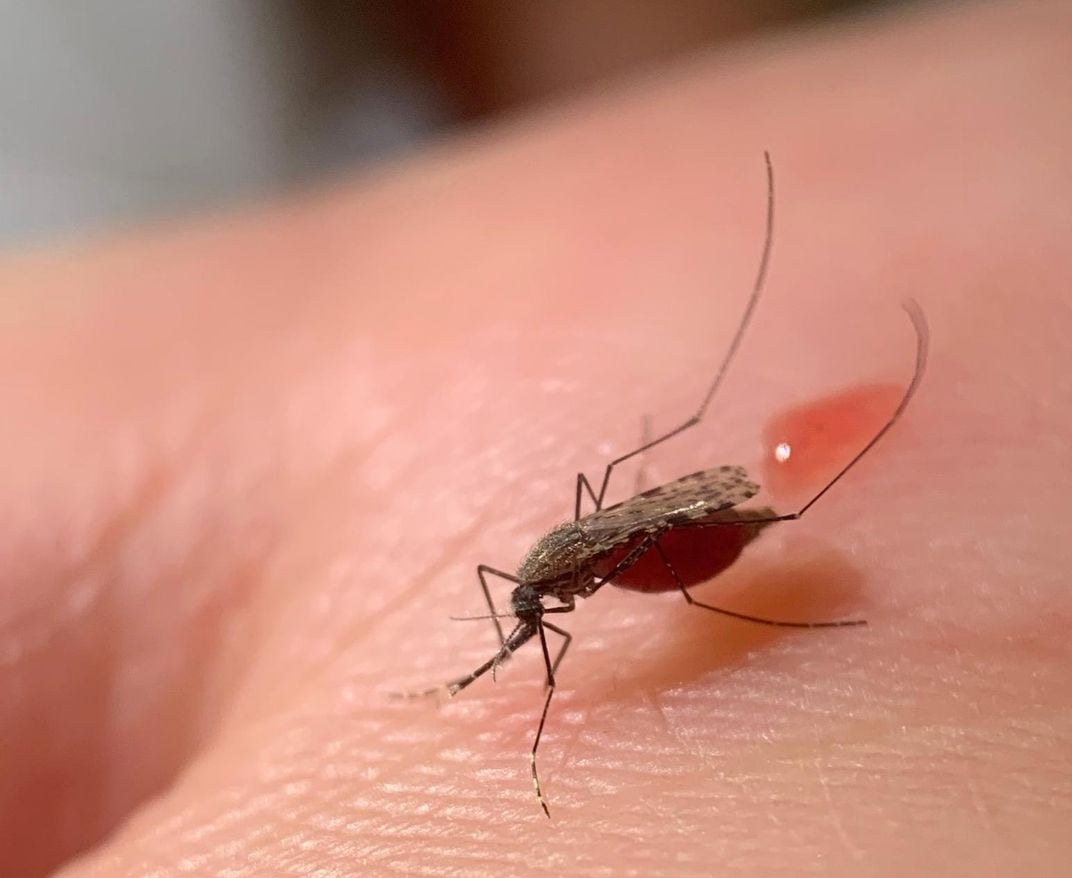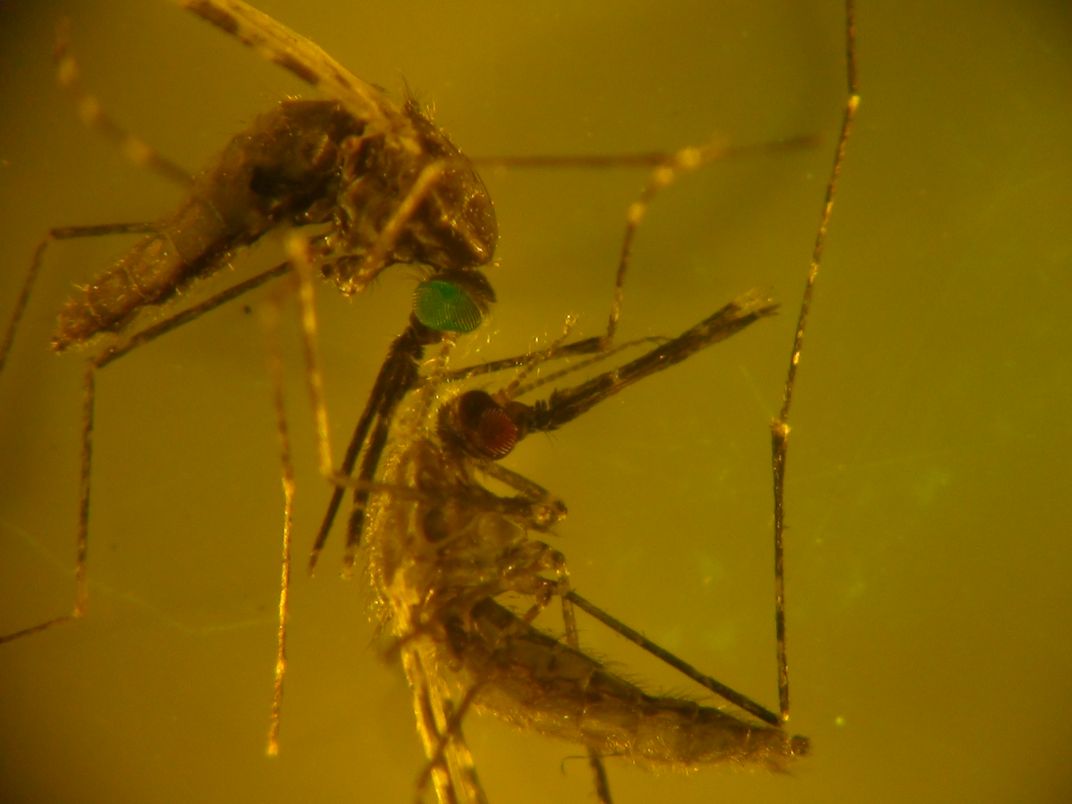Why Mosquitoes Find Your Warm Blood So Appealing
These bloodthirsty buggers repurposed a gene normally used to sense and avoid high temperatures into a heat-seeking molecular machine
/https://tf-cmsv2-smithsonianmag-media.s3.amazonaws.com/filer/6d/36/6d36ad97-6848-4889-ad5a-0f76db838f68/greppi2hr.jpg)
When his mosquitoes refuse to feed, Willem Laursen dons a pair of pantyhose.
“The smell [of feet] really attracts them,” says the Brandeis University biologist, who wraps his hosiery in a ring around the insects’ blood-filled feeding discs. “When you go outside, they go straight toward your ankles.”
Wild mosquitoes may harbor a seemingly insatiable thirst for blood, but their lab-grown counterparts—taken out of their natural habitats and penned in teeny, artificially lit chambers—sometimes struggle to rustle up an appetite. To keep the bugs at fighting weight, Laursen and his colleagues ply them with a suite of sensory cues, intended to mimic what they’d come across outdoors: warmth from a heated metal disc; puffs of carbon dioxide from exhaled breath; the alluring funk of human sweat emanating from unwashed nylon stockings.
The lab’s latest crop of mosquito mutants, however, have proved even tougher to coax than usual. Laursen and his colleagues have genetically modified the bloodsuckers to stop expressing a molecular thermostat called IR21a in their antennae, stunting their ability to home in on heat—and leaving them less prone to sup on servings of warm human blood.
The team’s findings, published today in the journal Science, represent the first time researchers have pinpointed some of the genes and cells responsible for mosquitoes’ attraction to heat. Understanding these molecular targets could someday aid the development of mosquito repellents or traps to bait the disease-transmitting bugs, which can carry the pathogens that cause malaria, dengue, Zika and more.

“Everybody knows that mosquitoes are annoying—they bite, and they’re everywhere,” says Sarah Zohdy, an infectious disease ecologist who wasn’t involved in the study. “But we still have some question marks about the basic underlying mechanisms that drive them. This really elegant study … addresses that gap in knowledge.”
For mosquitoes, nothing screams dinner like a body brimming with fresh, warm blood. But for a bug to actually buzz in for a bite, a whole slew of signals must first fall into place. Kicking things off are what Laursen calls the long-range cues—things like body odor and plumes of carbon dioxide that can entice the insects from several feet away. Once they come within a couple inches, the short-range triggers like temperature and humidity start to come into play, paving a clear path to a patch of delectable skin.
In the past several years, mosquito researchers have made big strides in determining what helps the bugs sense chemical cues from afar. But what keeps the insects on track as they gear up for landing has been “harder to pin down,” Laursen says.
To suss out the mosquitoes’ temperature-sensing strategy, a team led by Laursen and fellow Brandeis biologists Chloé Greppi and Paul Garrity turned to an unlikely source of inspiration: fruit flies. Though separated from mosquitoes by some drastic dietary differences and about 200 million years of evolution, fruit flies still share a lot of molecular machinery with their distant, bloodsucking cousins, Garrity says. One important difference? A lot of the temperature sensitivity in fruit flies has been worked out.

This evolutionarily minded strategy has actually been used before. In 2015, another group of researchers modified the mosquito genome to disrupt each of two genes that help fruit flies detect heat. But neither of the mutations appeared to quell the mosquitoes’ thirst for warm blood.
That finding was initially puzzling, Garrity says. The most traditional (and simplest) way to conceptualize heat-seeking behavior is through a set of cells or receptors that respond to increased temperature. “But there are two ways to be attracted to a warm object,” he says. “You can either seek out where the temperature is warmer, or be repelled by where the temperature starts to drop.”
So the researchers turned their attention instead to IR21a, a receptor that helps fruit flies sense, and ultimately migrate toward, cooler temperatures to keep from overheating. Genetically engineered to lack IR21a, Anopheles gambiae mosquitoes were no longer attracted to miniature heaters warmed to 98.6 degrees, a target that unaltered mosquitoes go bonkers for.
Mosquitoes without IR21a also showed less interest in warmed-up blood, offered to them in a heated disc attached to the top of their mesh cage—a setup that also provided the insects’ main source of food. (A cheaper but more bothersome option is for lab members to simply take turns sticking their forearms into the enclosure.)
To keep the mutant mosquitoes fed outside of these experiments, Laursen and his lab mates will bring the bugs extra blood, or blow into their cage to spike the air with carbon dioxide. They also frequently break out the pantyhose, though some members of the lab have proved more potent mosquito magnets than others. (They keep score on a whiteboard; Laursen is currently tied for second place.)

The team’s experiments suggest that, at the molecular level, IR21a functions pretty much the same in fruit flies and mosquitoes. But while it helps fruit flies avoid the heat, it makes mosquitoes navigate toward it. Mosquitoes, it seems, repurposed an evolutionarily ancient gene into a new cellular circuit—and flipped its function on its head. “Instead of just worrying about thermoregulation, mosquitoes are now using these temperature sensors to hunt humans,” says Laura Duvall, a mosquito behavior expert at Columbia University who wasn’t involved in the study.
Disabling IR21a, however, isn’t enough to completely flummox a hungry bloodsucker. When the researchers placed their bare hands on top of the mutant mosquitoes’ cages, the insects still flocked upward for a taste.
“Mosquitoes are exquisitely good at finding us,” Duvall says. With so many different sensory cues tickling the fancy of these bugs, “targeting a single pathway is never going to be enough … to disrupt that ability.”
But in fleshing out the list of lures that draw mosquitoes to humans, researchers may be on their way to developing more powerful repellents, including some that could discombobulate the bugs’ navigation skills.
Alternatively, a whole slew of these triggers could be combined into an ultra-appealing trap that seduces the insects away from skin. “This is a really attractive approach,” Duvall says. “It could have a huge impact. If you could reduce the number of interactions between mosquitoes and humans ... you could prevent all the diseases that those animals spread.”
/https://tf-cmsv2-smithsonianmag-media.s3.amazonaws.com/accounts/headshot/10172852_10152012979290896_320129237_n.jpg)
/https://tf-cmsv2-smithsonianmag-media.s3.amazonaws.com/accounts/headshot/10172852_10152012979290896_320129237_n.jpg)